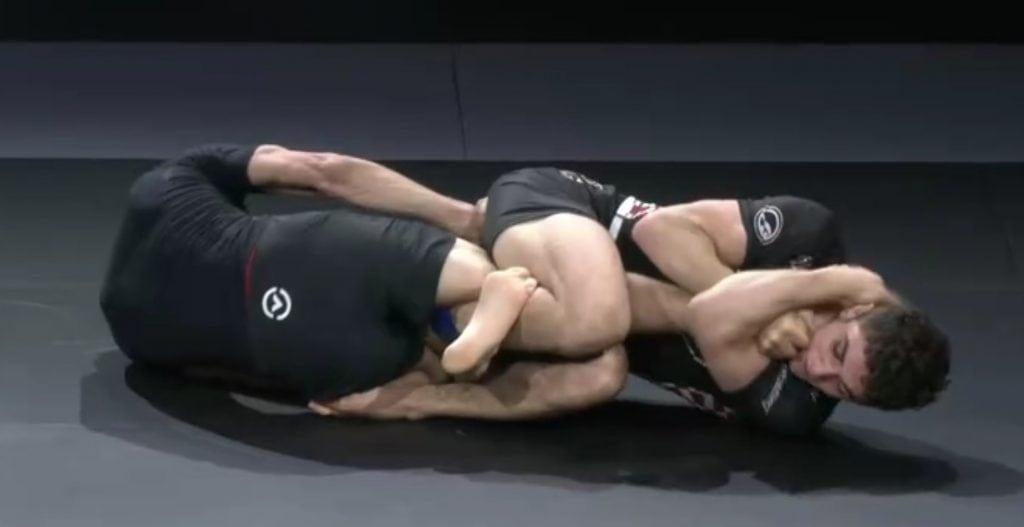Leg locks are fearsome and infamous weapons. If applied well, they are among the most effective submissions in grappling and BJJ. But if applied poorly, they can be dangerous for yourself and your training partners. Understanding leg locks theoretically will help you train with them safely and effectively. So in this article you’ll read what leg locks are, why some are illegal, which leg locks are dangerous and why, and which are the best leg lock submissions.

What are leg locks?
Leg locks, also called leg submissions, are submissions that target the ankle and knee joints. Leg locks are usually applied from the guard position, with the guard player using his legs to trap the opponent’s legs. But leg locks can also be applied from other positions, such as the top position or even from standing.
While leg locks are mainly used in BJJ, they can be used in other grappling arts such as Sambo and Judo. Leg locks can also be used in a street fight or MMA, but this is more rare.
Are leg locks illegal?
Some leg locks are illegal in some forms of BJJ, whereas other leg locks are allowed in BJJ. Which leg locks are illegal depends on your belt rank, whether you do gi or no gi, and the organization in which you compete.
What leg locks are legal at white belt?
There’s only one leg lock that’s legal at white belt in BJJ: the straight foot lock. This is the most safe leg lock in BJJ, because it doesn’t involve rotation and attacks the ankle instead of the knee.
What leg locks are legal in gi?
In the IBJJF rules, the straight ankle lock is the only legal leg lock for white belts, blue belts and purple belts. For brown and black belts, knee bars, toe holds and calf slicers are also legal. Heel hooks and knee reaping are not legal in gi Brazilian jiu jitsu.
Which leg locks are legal in no-gi grappling?
Which leg locks are legal in no gi grappling depends on the organization. But in most no gi competitions, all leg locks are legal. So that includes footlocks, knee bars, toe hold and heel hooks.
Why are leg locks illegal?
There are multiple possible explanations for why leg locks are illegal in BJJ. Which explanation you get, depends on who you ask. I don’t know which explanation is true, maybe both are true.
If you ask the Gracie family, the founders of modern jiu jitsu, leg locks are illegal for two reasons. Firstly, because they are too dangerous. Secondly, because white belts won’t learn how to pass the guard if you allow them to jump on leg locks.
But if you ask other people, they’ll say that heel hooks are illegal in BJJ because the Gracies were bad at them. To prevent themselves from losing in competitions, they made these leg locks illegal.
Are leg locks dangerous?
Yes, some leg locks are more dangerous than other submissions. There’s two reasons for this.
Firstly, heel hooks attack the knee in a sideways manner. This is more dangerous than for example a straight knee bar, because you don’t feel pain before your leg snaps sideways. Rickson Gracie compares this to your finger joint: if you bend it backwards it hurts before it breaks, but if you bend it sideways it will first break and then hurt.
Secondly, knee injuries are more problematic than many other injuries. They heal slower and cause you more problems in your daily life. They often require surgery and take months to heal, which isn’t true for, for example, an elbow injury.
The 6 best leg lock submissions in BJJ
BJJ has many effective leg lock submissions. Here are some of the best ones.
1. The Heel Hook
The heel hook is one of the most effective submissions you can use on the mats. It’s currently the most common submission at high level no gi BJJ tournaments. It’s also recently made legal in the IBJFF Worlds no gi competition.
There’s two forms of heel hook, the inside heel hook and the outside heel hook. Both are effective, but the inside heel hook is more devastating and also easier to finish Both variations attack your opponent’s knee joint.
2. The Mikey lock
The Mikey lock is a new variation of the inside heel hook that Mikey Musumeci invented. Instead of putting your opponent’s heel into your arm pit, you put it in your ‘neck pit’. According to Mikey, this gives you more leverage and makes it harder to slip the heel.
3. The toehold
The toe hold is a submission in which you twist your opponent’s foot to crush his ankle. At the highest levels, this leg lock is almost completely ineffective, because high level competitors don’t tap to it. They rather accept the relatively mild ankle injury that it causes. But at the lower levers, where people care about injuries. the toe hold works.
4. The knee bar
The knee bar is among the hardest leg locks to get right. You try to break your opponent’s leg in half with your hips, the same way you try to do to his arm with an armbar. But if your angle is slightly off, you won’t get it.
Nevertheless, the knee bar is an important tool in your leg lock arsenal, because it combines very well with the other leg submissions.
5. The straight footlock
The straight footlock is the best leg lock for beginners. It’s easy and it’s legal at all levels.
At high level competitions, people almost never tap to ankle locks. This is because it causes only mild injuries. The only person that seems to get them to work at the highest levels is Mikey Musumeci.
6. The Aoki lock
The Aoki lock is a variation of the ankle lock, in which you leave the heel out of your arm pit. This causes rotation in the knee, which makes this leg lock feel more like an inside heel hook.
Strictly speaking the Aoki lock is illegal in gi jiu jitsu, but since it’s so hard to distinguish from a straight footlock, nobody ever gets disqualified for it.
7. The Estima Lock
The Estima lock is a dangerous toe hold variation that only works if you apply it very quickly. You get a rear naked choke grip on the foot and push it into your belly, and then you push your belly in to break the ankle. This move is effective in competition, but you can’t really use it in training because it doesn’t work if you do it slowly.
8. The Calf Slicer
The calf slicer doesn’t work. That’s right, I said it.
Now obviously, there are exceptions to this rule. For example, a black belt like Gordon Ryan, Eddie Cummings or Dean Lister can definitely submit me with a calf slicer. I’m sure.
But, it’s among the 5 worst submissions in all of BJJ. It’s very inefficient. Moreover, you can damage your own knee with it. I’ve had 2 training partners pop their own knee while trying to calf slice me.
So don’t do calf slicers kids. It’s a worthless leg submission.
FAQ
Are leg locks legal in wrestling?
No, leg locks are not legal in wrestling. In fact, freestyle wrestling and Greco Roman wrestling don’t allow any submissions at all, which is the biggest difference between wrestling and BJJ. The only form of wrestling that allows leg locks is ‘submission wrestling’, which is more similar to BJJ than to wrestling.
Are leg locks legal in judo?
No, leg locks are not legal in Judo competitions. They are considered too dangerous. This is a big difference between Judo and BJJ. But, if you study old Judo manuals, you’ll see that the old masters did practice with some leg locks and leg entanglements, which they called ashi garami.
Are leg locks legal in ufc?
Yes, all leg locks are legal in the UFC. There are absolutely no rules that prohibit the use of leg locks in mixed martial arts. But, leg locks aren’t common in the UFC because they often leave you vulnerable to strikes from your opponent. Some famous leg lock specialists in the UFC are Ryan Hall and Palhares.
